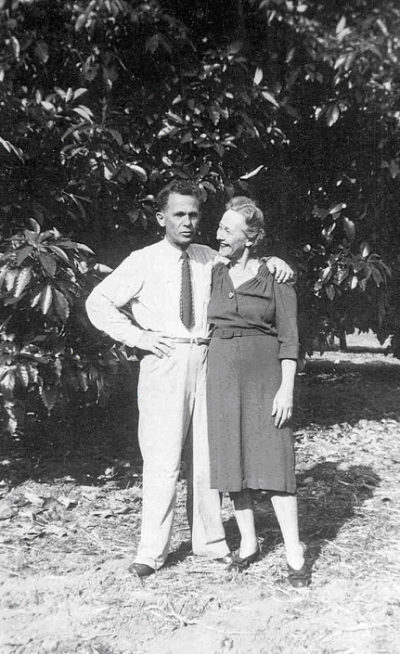Rudolph Hass (Rudolph Gustav Hass)

After reading a magazine article illustrating an avocado tree with dollar bills hanging from it in 1925, Rudolph Hass used all the money he had, plus a loan from his sister, Ida Hass, to buy a small acre and a half avocado grove at 430 West Road La Habra Heights, California. The trees were old Fuerte avocados with 2 or 3 Lyon as well as a few Pueblas and Nabals. The Fuerte was the best avocado available at that time, but Hass could not afford to buy more trees, so he decided to cut down many of the old trees and have them grafted over to Fuerte with new bud wood. Rudolph Hass hired a professional grafter named Mr. Caulkins, who advised Mr. Hass to buy avocado seeds from a nursery owned by Mr. Rideout and grow his own seedlings and then have them grafted to the Fuerte variety. Hass agreed and followed his advice. He planted the rest of the grove on 12-foot (3.7 m) centers with three seeds in each hole. Cuttings from existing Fuerte trees were grafted onto the strongest of the three newly planted trees from each hole. All but three of the grafts ‘took’ and new Fuerte trees grew out of the new seedlings. Mr. Caulkins re-grafted those three trees. Then he re-grafted the one tree that had rejected the second graft. Again it did not take. Hass was ready to give up and asked Mr. Caulkins to chop it down, but he told him it was a good strong tree, and advised Hass to “just leave it alone and see what happens.” So Hass did. Mr. Hass was not a botanist like Luther Burbank (1849 – 1926) who purposely cross pollinated plants to produce over 800 better varieties. The seed that produced the Hass Avocado had already been cross pollinated by nature before Mr Rideout sold it, along with a hundred other seeds, to Mr. Hass.
When that seedling was 14″ tall and the trunk only 1/2″ thick, it had three walnut size fruit on it. Fuertes rarely produced fruit in less than five years. Rudolph Hass had his wife Elizabeth take his picture kneeling by the seedling and showing one of the tiny avocados hanging over his hand. This was in July, 1926. That picture has been immortalized in a portrait painted by Rudolph Hass’s grandson, Thomas Wilkes. That seedling grew more rapidly and produced more fruit than the Fuerte grafts. It also grew straight up and was not as spread out as the Fuerte trees making more trees to the acre possible. When the fruit grew large enough and mature, Hass picked them to ripen. The family agreed that this avocado tasted as good, if not better than the Fuerte. As the tree grew and produced more fruit than the family could use, Hass took some to his co-workers at the Pasadena Post Office. They liked the avocados and asked if they could buy more from him. He agreed to sell them a bag of 4 or 5 avocados for $1. He sold all he brought to work and took orders for more. The Hass family began to work harvesting and selling avocados from a roadside stand by the grove at 430 West Road in La Habra, California. Rudie also contacted the ‘Model Grocery Store’ on Colorado St. in Pasadena and found it to be a ready market. He left them a few sample avocados and they agreed to sell the fruit and did so for many years. The chefs of wealthy people who lived on South Orange Grove Street shopped there, and once they sampled the Hass variety, they insisted upon it. At $1.00 each, Avocados were only available to the rich. A dollar a day was a typical food budget for a family of four or five in those days.
In August 1935 Rudolph Hass patented his ‘Hass’ avocado tree. Rudolph Hass signed an agreement with Harold Brokaw, a Whittier nurseryman, to grow and sell the Hass Avocados. Hass was to receive 25% of the proceeds. However, the patent was widely violated. Growers would buy one tree from Mr. Brokaw who had the exclusive right to produce the nursery trees. They would then re-graft their whole grove with the bud wood from that one tree. For that reason, Rudolph Hass made less than $5,000 in royalties over the life of the patent. (Patents expire after 17 years.) However, Rudolph Hass was the first person to have a producing grove of Hass Avocados, though it was a very small grove. Rudolph Hass expanded to Fallbrook, planting an 80-acre (320,000 m2) orchard in 1948 which bore its first crop in 1952, just as his 17-year patent expired. One month after the patent expired in August 1952, at the age of 60, Rudolph Hass suffered a heart attack on September 24, 1952. He died of heart failure in the Fallbrook Hospital a month later on October 24, 1952.
Born
- June, 05, 1892
- USA
- Milwaukee, Wisconsin
Died
- October, 24, 1952
- USA
- Falbrook, California
Cause of Death
- heart failure
Cemetery
- Mountain View Cemetery and Mausoleum
- Altadena, California
- USA

